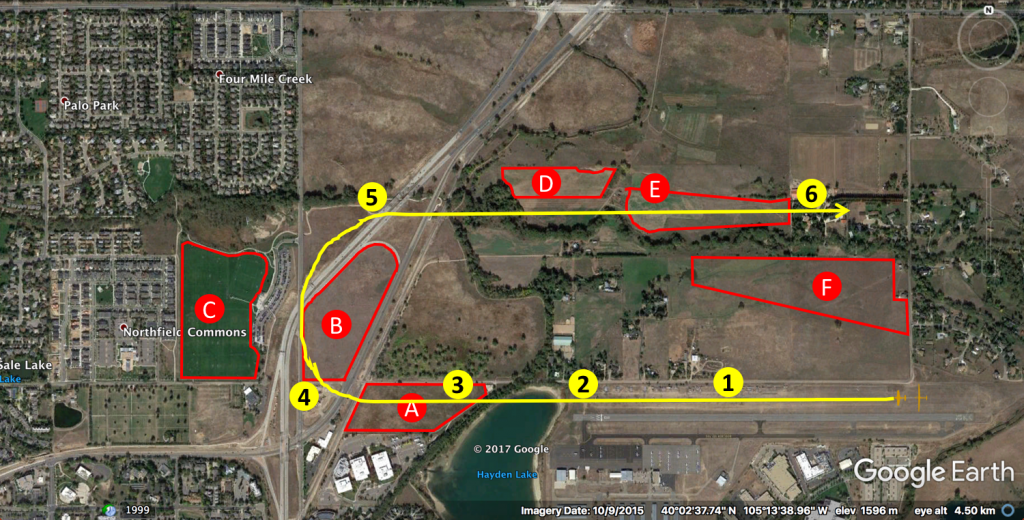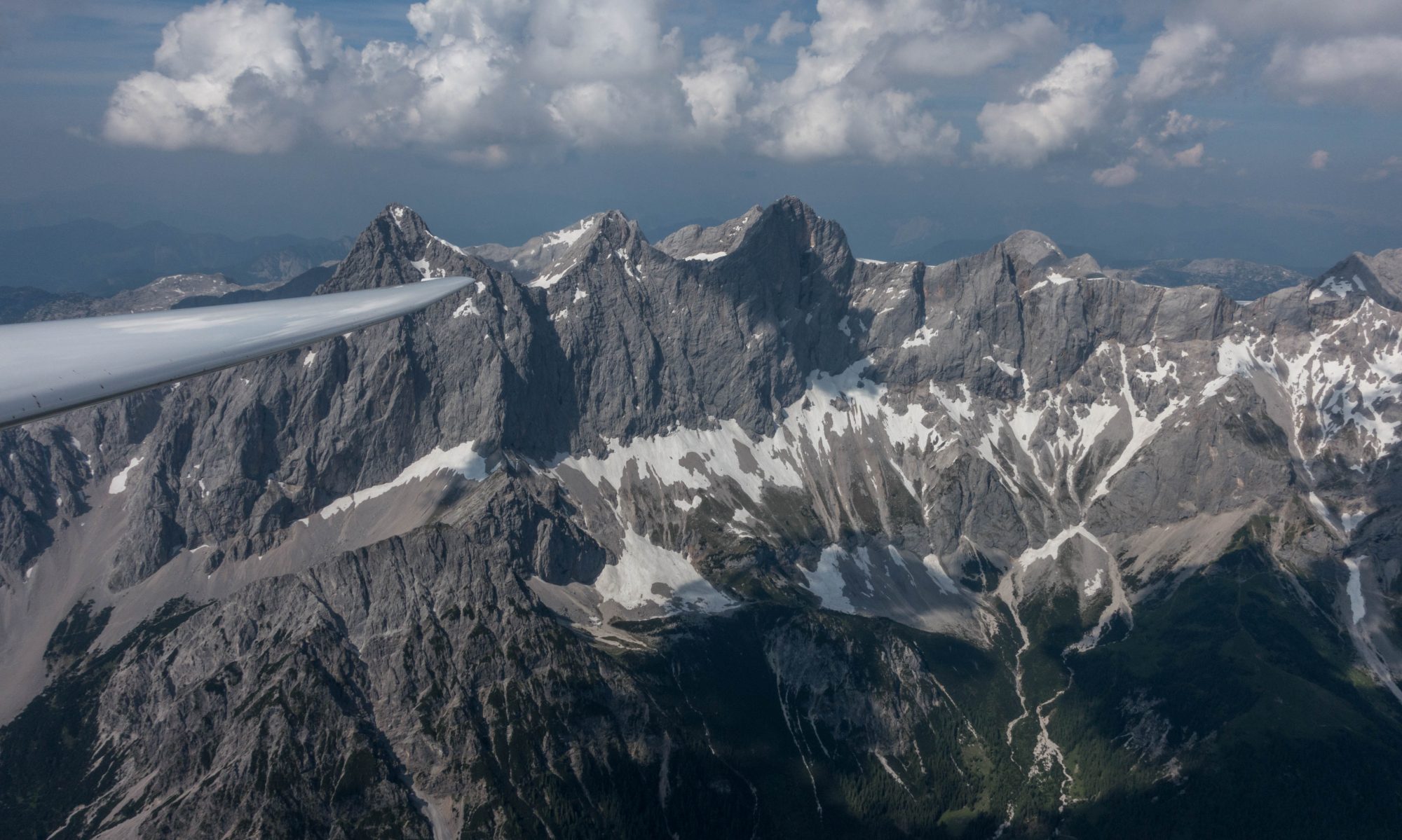My club, the Soaring Society of Boulder, has a designated plane for wave flights above 18,000 feet: an old Schweitzer SGS 1-34. Yesterday I got checked out in it. The plane looks old because it is: built in 1978 it has already experienced a lot.

A few things make it particularly well-suited for wave flights:
First, it is made of aluminum. There is no sensitive gel-coat that could crack when you’re descending from 35,000 feet where air temperatures might be 50 or 60 degrees Celsius below zero. A side benefit is that the plane can park assembled outside all year long and doesn’t even need covers (except for the canopy). Just get rid of any snow and fly!
Second, it has terminal velocity dive breaks: that means if you need to come down fast (e.g. if the oxygen system should malfunction), you can. Just point the nose straight to the ground, pull the dive breaks out and you won’t exceed the maximum allowed airspeed. That sounds wild but it will get the job done if you need to breath.
Third, it is very well equipped for wave flights: not only does it have a transponder that will make it visible to Air Traffic Control (after all you might be flying at altitudes normally reserved for commercial jet traffic), it even has two oxygen systems including a pressure demand system certified for flights up to 45,000 feet. Wow! I wouldn’t go nearly that high even if I could. I don’t know if there’s anything on my body that wouldn’t freeze off at that altitude! Also, it really is seriously dangerous to do so in a non-pressurized cabin.
- West Wind Takeoff
Flying in wave at Boulder likely means contending with west wind takeoffs. A few weeks ago I did a separate check out for those because they can be quite tricky.
The airfield in Boulder is less than 3 miles away from the Foothills. The westerly winds that trigger the wave flow down the slope of the mountains. This means that just to the West of the Boulder airport their could be nothing but massive sink. This could be made worse by potentially severe rotor turbulence, which can quickly put an end to an aero-tow: tow plane and glider could easily get so out of position that either is forced to release, or the tow rope may simply break. (A local tale tells of a towplane getting inverted in rotor turbulence where the pilot was able to roll back while the glider was hanging on… Another tells of a glider releasing in massive turbulence a few hundred feet above the ground and being able to circle away in rotor lift…) Needless to say that if any of these things happen right after takeoff, you can quickly find yourself in an emergency where you have to pick the next field and land because returning to the airport might be impossible.
Adding to the challenge is the lack of good fields should you find yourself in this situation. Just to be clear: there are fields around and it is very likely that you will be able to reach one of them but you may have to decide immediately what to do (within a second or two) and most of them are not great for landing. I want to be prepared if such a situation ever arises and I have therefore created the following map with potential out-landing fields and key decision points.

The potential landing fields are marked A through F. Key decision points are marked 1 through 6.
At Boulder, the default runway is 08 – i.e. takeoff to the East. West wind takeoff (i.e. runway 26) is normally only used if there is considerable wind from the West (min 5-8 knots or more, which would make a tail-wind takeoff to the East too risky or impossible).
For a West wind take-off, gliders are moved all the way to the East, one tow-rope length (200 feet) beyond the end of the asphalt strip. The graph above shows a stylized image of a tow-plane and glider in staging position. Club policy requires the use of a powerful tow-plane for West wind takeoffs.
Once the towplane starts moving, the first decision point comes up very quickly: if the tow-plane is not air-born just after the middle of the runway, it is time to release and abort: there is still enough runway ahead to land the glider safely while the tow-plane takes off on its own and flies a pattern.
After decision point 1 the next landing possibility is Field A. It is located behind a row of trees at the West side of the little lake. The trees can create significant turbulence in their wake. If the glider is forced to release at an altitude insufficient to clear the trees (usually somewhere between point 1 and point 2), the best bet is still to land straight ahead, even if it might mean running out of runway and ending up in the lake.
At point 2 it is very likely that the glider can clear the trees ahead and at this point the best option is to land in Field A. The field is about 1,200 feet long, which is not a lot because you have to first fly over the trees, but it should be sufficient, especially if the headwind is fairly strong. The surface is fairly rough with a lot of holes from prairie dogs and there is a small tree to avoid.
At point 3, the default option should be Field B. It is equally rough as Field A but it is long enough (1,500 feet) and the obstacles in it should be avoidable. Field C (Pleasant View Soccer Fields) may or may not be an option: it is obviously flat and in great condition but there may be people in it or the movable goal posts may be arranged in a way that prevents a save landing. Only chose it over Field B if you’re certain that you can land safely without endangering anyone. (There may be no time to decide, which is why the default option is Field B.)
At point 4, the best plan depends on your altitude: if you’re very low and descending fast, Field B may still be an option. If you’re already fairly high, it might even be possible to return to the airport. If it’s somewhere in between, then Field D may be the best option. It’s 1,100 feet long and you have to clear bushes and trees but it should be doable.
At point 5, you should already have multiple options, depending on your altitude. A downwind landing on runway 8 may be possible. And if not, Fields D, E, and F should be within reach. At point 6, a safe return to the airport (and landing to the West on runway 26) should be possible.
As always, it is good practice during takeoff, to call out the field(s) that you would be landing at should the tow be terminated at that point for any reason. This way you already know what the decision is should anything happen and can concentrate on executing your plan rather than waste precious seconds (and altitude) in formulating one.
- Opening the Wave Window
The airspace above 17,999 feet is designated Class A airspace in the US. Flying above this level requires special permission from air traffic control. Therefore, the final piece to flying high in wave at Boulder is the procedure to open the Arapahoe Peaks Soaring Area wave window. It is as follows:
Before the flight, call the Denver Flight Desk at 303-651-4247. You will talk to the “Mission Desk at the Air Traffic Control Center”. They will ask for the following information:
– Your name
– Name of the Airspace: “Arapahoe Peak Soaring Area”
– The requested altitude expressed as “Flight Level”, e.g. 30,000 feet is FL300
– The time frame (in UTC, i.e. “Zulu Time”) for when you would like the window to be opened.
– The aircraft registration (N number)
– Tell them that the aircraft is equipped with a transponder. They will tell you a squawk code to use instead of 1202.
Calling them is just a pre-notification! Once air-born you will still have to call the Denver Center on the radio at frequency 128.65 MHz (or another frequency that may be assigned to you) for your aircraft to be cleared into the Airspace.
Also, remember that above 18,000 feet = FL180 (the “transition altitude”) you must set your altimeter to 1013.25 hectopascals (millibars) or 29.92 inches of mercury.
While flying above FL 180 you must remain in radio contact with the Denver Center and follow all instructions.
Once below 18,000 feet you must contact Denver Center at 128.65 MHz (or on the phone) that the Airspace is no longer needed. Also, after exiting the wave window and calling the Denver Center, re-adjust your transponder back to squawk code 1202.

